System level electromagnetic environment effect test design and evaluation technology
First, the electromagnetic compatibility and electromagnetic compatibility test will be explained. Electromagnetic compatibility is based on the control of electromagnetic emissions and electromagnetic sensitive protection to achieve the normal operation of military equipment. Generally, electromagnetic compatibility requirements include electromagnetic emission requirements and sensitive requirements. The electromagnetic emission should not exceed the limit value, and the electromagnetic sensitivity should not be lower than the limit value. The electromagnetic compatibility problem is very complicated, mixing a lot of factors, even in the case of DC, there are electric and magnetic fields. As the complexity of the system increases, the complexity of the problem will increase exponentially. Electromagnetic emission and electromagnetic sensitivity exist in military equipment in the form of fields and waves, like meridians, so as the complexity of the system increases, the complexity of electromagnetic compatibility problems increases exponentially. Whether the electromagnetic compatibility of a product meets the requirements will be verified by testing. The biggest difference between electromagnetic compatibility and scattering, stealth and antenna problems is that it is a near-field and quasi-near-field problem. The electromagnetic compatibility test is a near-field and quasi-near-field test. The test sensors are mainly probes and antennas. The figure is a typical electromagnetic compatibility test shielding room.

The system level is relative to the device. We know that the test object in the electromagnetic compatibility test of the device is a single device or a sub-system, and the device composition, the number of cables, and the coupling relationship are relatively simple. The system level includes single-body systems and multi-body systems, as well as systems such as drone systems that are distributed on the ground and in the air. System level electromagnetic compatibility tests also face cable test problems that are much more complex than the device level. Furthermore, system-level electromagnetic compatibility testing should also consider the adaptability to the use environment, including the ship's environment and formation environment. Why should the system-level electromagnetic compatibility test consider ship surface adaptability and adaptability of formation and battlefield electromagnetic environment? Because the general requirements of the development of the functional performance requirements of the equipment is applicable to the equipment use conditions, so for equipment with shipboard and formation requirements, this performance should be assessed in the system-level electromagnetic compatibility test. It goes without saying that such a complicated experiment must be carefully designed. So what is the relationship between system-level electromagnetic compatibility and the adaptability of the battlefield electromagnetic environment? To this end, the basic concepts related to electromagnetic compatibility are introduced below. In particular, it is stated that electromagnetic emission and electromagnetic sensitivity are inherent properties of the test article. And therefore the five major relationships between electromagnetic environmental adaptability, electromagnetic environmental effects, electromagnetic compatibility, and electromagnetic interference.
Second, the basic concepts related to system-level electromagnetic compatibilitySystem-level electromagnetic compatibility is defined in GJB 72A as a combination of several equipment, subsystems, full-time personnel, and technology that perform or guarantee a work task. A complete system includes operators, including facilities, equipment, subsystems, equipment, and ancillary equipment. GJB 1389 is a requirement for system-level electromagnetic compatibility, and GJB 1389 is derived from the US military standard MIL-STD 464, which is the system-level electromagnetic environmental effect requirement. The system-level electromagnetic environmental effects promulgated by the US military in 2002 required 14 relevant requirements in GJB1389A, including our well-known requirements for electromagnetic compatibility (ie, self-compatibility) within the system, and electromagnetic emission and electromagnetic sensitivity requirements for equipment subsystems. In summary, strict requirements are requirements (the first major relationship: the relationship between system-level electromagnetic compatibility and system-level electromagnetic environmental effects), in addition to the conventional equipment sub-system electromagnetic emission and electromagnetic sensitivity requirements, system self-compatibility requirements It also includes the electromagnetic environment effect requirements of the battlefield, such as the RF electromagnetic environment effect requirements of friendly and enemy, and even the requirements of threatening environmental effects such as electromagnetic pulse effect requirements; anti-information leakage requirements; prevention of premature detection of electromagnetic emission control Requirements; spectrum compatibility requirements, etc. In 2010, the US military standard updated MIL-STD 464 to version C. Two changes were worthy of attention. One was to increase the requirements for high-power microwave effects; the other was to upgrade spectrum compatibility to electromagnetic spectrum support requirements.

This picture reflects the evolution of the electromagnetic environment effect: from the conventional electromagnetic spectrum management based on ground operations to the initial electromagnetic environment effect for the purpose of global warfare, considering lightning and electromagnetic pulse, to the electromagnetic Lethal weapons, considering the effects of radio frequency radiation on ordnance, fuel, personnel injuries, and new electromagnetic environmental effects that adequately protect against electromagnetic vulnerability and electronic warfare. It can be seen that the electromagnetic environment effect has become an important means of making electromagnetic power.
So what is the relationship between the electromagnetic environment effect and the electromagnetic environment adaptability (the second largest relationship: the relationship between the system-level electromagnetic environment effect and the electromagnetic environment adaptability)? The US military standard uses the electromagnetic environment effect and spectrum support as the equipment's ability to adapt to the natural environment and the non-combat battlefield enemy and the electromagnetic environment, and regard it as the premise of survival and the basis of warfare. The ability to adapt to the environment as an equipment for electronic countermeasures is seen as a means of electronic attack and defense. I believe that the adaptability of the electromagnetic environment should be composed of two parts: one is the natural environment and the non-combat battlefield enemy electromagnetic environment adaptability, which is the equipment survival premise and operational basis; the second is the electronic countermeasures environmental adaptability, which is the electronic attack and defense means. As shown below:
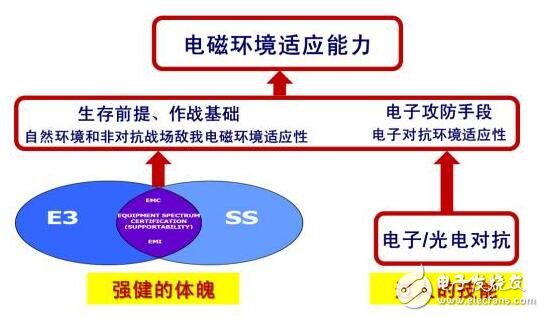
I believe that the electromagnetic environment effect and the electromagnetic spectrum support ensure that the equipment has a "strong body", and the electronic/optical countermeasures make the equipment "extraordinary skills." The following metaphors can be used to illustrate the mutual support of the two: when A and B fight against the game, if A has a strong body and B is very weak relative to A, then A and B will have a distinct advantage when playing with A. But if weak B has an extraordinary skill that A does not have, B can also win. However, if A has both strong physique and extraordinary skills, even if B is superior in skill, A and B will have a greater advantage in the game.
With the promulgation of the GJB 8848-2015 national military standard, the test assessment of GJB 1389A will be gradually implemented. It is necessary to analyze the connotation and relationship between the electromagnetic environment effects of 15 items in GJB 1389A. After long-term research, I believe that the 15 requirements in GJB 1389A can be divided into five categories: 1) self-compatibility requirements; 2) anti-expected electromagnetic environment interference requirements; 3) adaptation to natural environment requirements; 4) actual combat and damage environment requirements ; 5) actual combat capability and continuous combat capability requirements. The following analysis is performed in order:
For information equipment that integrates reconnaissance, detection, communication, navigation, interference, and strike, firstly, because high-sensitivity receiving equipment and high-power transmitting equipment coexist on the same platform, its own electromagnetic interference characteristics and electromagnetic compatibility requirements are the primary The problems correspond to the two requirements of equipment level system EMI and system EMC in GJB 1389A-2005;
Secondly, since reconnaissance, detection, communication, and navigation equipment are required to have the functional performance required by the reconnaissance, detection, communication, and navigational warfare technical indicators in the expected electromagnetic environment, their ability to resist the expected electromagnetic environment interference is the second required surface. The corresponding problems correspond to the three requirements of safety margin, external RF electromagnetic environment and electromagnetic radiation hazard in GJB 1389A-2005;
Third, as equipment directly exposed to the actual environment, it is a problem that cannot be ignored in dealing with natural environments such as lightning and static electricity. It corresponds to four requirements of lightning, electric lap, external grounding, and electrostatic charge control in GJB 1389A-2005.
Fourth, as the main application of military applications, ensuring the survivability against the environment is the key to the actual combat capability of the equipment, corresponding to electromagnetic pulse, anti-information leakage, emission control, high-power microwave in GJB 1389A-2005. Claim;
Fifth, for equipment with practical combat capability and continuous combat capability, GJB 1389A-2005 further proposes full-life electromagnetic environment effect control and electromagnetic spectrum support requirements, the purpose of which is to control the electromagnetic emission of electronic equipment in the use area. The abnormal occupancy of the spectrum ensures that more electromagnetic spectrum resources can be actively regulated.
We have carefully analyzed why the US military standard believes that the electromagnetic environment adaptability of the battlefield can be achieved through these 15 electromagnetic environmental effects tests. The conclusion is that it starts from the equipment effect. By studying the characteristics of the battlefield electromagnetic environment, the battlefield electromagnetic environment can be divided into these 15 basic elements, and this decomposition is a decomposition of physical properties, whether it is transmitting signals or receiving signals, it can be calibrated, Repeatable, we have come to this conclusion based on our research on 151 and 461. Both the US military standard 461 and the national military standard 151 are all expected to achieve electromagnetic compatibility of the equipment subsystem. However, both types of standards impose limits on electromagnetic emissions and electromagnetic sensitivity, ie EMI, from physical properties. Moreover, the test object is evaluated from physical properties, and both the applied signal and the detected signal are emphasized to be calibratable and repeatable.
The following is an analysis of the relationship between equipment subsystem EMI and electromagnetic compatibility within the system. I don't know if you noticed that in GJB1389A, the electromagnetic compatibility requirements are put forward in the system, and the electromagnetic interference requirements are proposed for the sub-system equipment. This requires understanding what is EMI and EMC (the third largest relationship: the relationship between electromagnetic interference and electromagnetic compatibility)?
Electromagnetic interference, including electromagnetic emission and electromagnetic sensitivity, is an inherent property of products; there is a subset of electromagnetic sensitivity called electromagnetic vulnerability. Electromagnetic interference and electromagnetic vulnerability are related to the electrical design principle of the product (excitation source characteristics, nonlinear module characteristics, Circuit Board layout and impedance matching between boards), structure, layout, process, etc. Load conditions and other related. Electromagnetic compatibility is based on self-compatible targets that impose limit values ​​on electromagnetic interference. Only when the limit requirements are met can it be said to be electromagnetically compatible. Electromagnetic vulnerability refers to electromagnetic sensitivities that can cause serious failures, performance degradation, and safety threats to people or products. Electromagnetic vulnerability is also an inherent property of the product. As with sensitivity detection, there is a risk of missed detection by using frequency sweeping. For vulnerability, missed detection means a serious hidden danger. The figure is electromagnetic interference and electromagnetic compatibility.
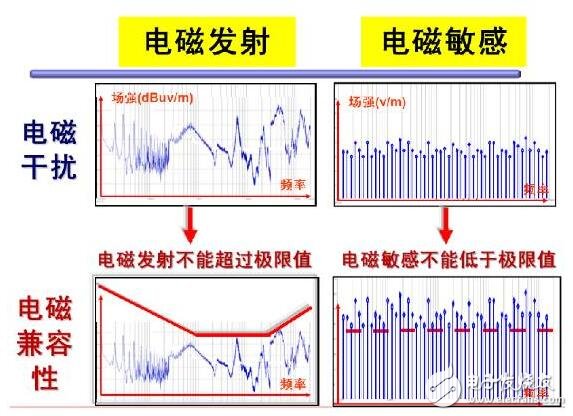
In order to achieve the electromagnetic compatibility of the equipment subsystem, the National Military Standard has set limits for each electromagnetic emission and electromagnetic sensitivity test. However, please note that the method used in the stereotype test is a method for detecting EMI characteristics. The detected electromagnetic emission and electromagnetic sensitivity characteristics are characteristics corresponding to the design principle, process, layout and structure of the test object. Therefore, for the limit requirements of the military standard, it is only possible to meet the limit requirements by designing and implementing the design into the principle, process, layout and structure.
Below we answer GJB 1389A-2005 why the EMC requirements for the system, EMI requirements for the equipment subsystem. Since GJB 1389A proposes electromagnetic compatibility requirements from the system level, it is necessary to fully grasp the electromagnetic emission and electromagnetic sensitivity characteristics of each subsystem and equipment that make up the system, in order to optimize the electromagnetic compatibility within the system. Just as the squad leader has mastered the characteristics of the whole class, it can make the whole class a united and combative group. We call this the electromagnetic compatibility attribute composition relationship. This "attribute relationship" can also be extended down to subsystems, devices, boards, devices, etc., and scaled up to between systems, systems, and environments. That is, based on the basic attributes of the hierarchical constituent units, the performance of this level is optimized. Next, the electromagnetic spectrum support will be explained. Electromagnetic spectrum support refers to the ability to effectively use specific frequencies and bandwidths between different products to ensure the ability to work together and perform effectively in the expected electromagnetic environment. Unlike electromagnetic spectrum management, the electromagnetic spectrum supports the use of active coordination techniques. This also fully illustrates the fourth relationship: the relationship between system-level electromagnetic compatibility and the adaptability of the battlefield electromagnetic environment.
In summary, electromagnetic interference and electromagnetic environmental effects are inherent attributes of equipment. Electromagnetic compatibility and electromagnetic environment adaptability are the limit requirements for equipment. The electromagnetic interference and electromagnetic environment effects of equipment can be detected through testing, but must be designed. In order to enable the test article to meet the limit value requirements.
Third, the system level electromagnetic compatibility test design pointsFirst, since GJB 151 and GJB 1389 test electromagnetic interference (EMI) and electromagnetic environmental effects (E3), electromagnetic compatibility (EMC) and electromagnetic environment adaptability (EMA) can only be achieved through design, so the experimental design One point is to be based on the system, subsystem, and equipment design process. Secondly, since the electromagnetic compatibility in the GJB 1389A system is based on the electromagnetic emission and electromagnetic sensitivity characteristics of the subsystems and equipment that make up the system, the second point of the test design is to use the equipment to separate the system electromagnetic emission and electromagnetic sensitivity test results. Based on. Third, because the current form of equipment has developed into multi-entity and ground air coordination; fourth, and to adapt to the ship's electromagnetic environment and formation and battlefield electromagnetic environment, so the third and fourth points of the experimental design is to equip the equipment Based on functional and functional performance, based on the actual use of the electromagnetic environment.
1. Based on system, subsystem/equipment design process
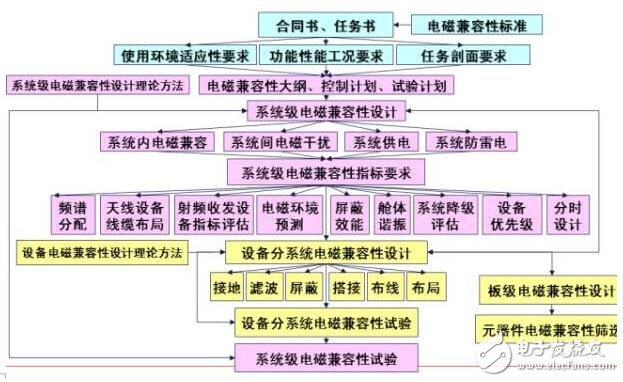
The above figure shows the work related to electromagnetic compatibility in the design and development of systems, subsystems and equipment, including general development requirements, system-level design and equipment-level system-level design. Based on the design process, it is necessary to comprehensively sort out all the fault phenomena and faults in the development process, and as one of the key contents of the test verification, write the test outline and use the functional performance corresponding to the fault phenomenon as a sensitive judgment. according to.
2. Based on the electromagnetic emission and electromagnetic sensitivity test results of the equipment
If the electromagnetic emission and electromagnetic sensitivity limit requirements for the equipment subsystem are directly from GJB151, and only the equipment single test meets the limit value, but the functional performance is not used as a criterion, and the platform is not working properly as a criterion. There will be hidden dangers between equipment electromagnetic compatibility and system-level electromagnetic compatibility and system-level operating conditions. In order to solve this problem, it is recommended to first establish a jamming relationship between devices in the carding system and establish an interference correlation matrix. For example, for military aircraft, all devices that are associated with high-sensitivity receiving devices (which operate simultaneously with high-sensitivity receiving devices and whose frequency bands may overlap each other) are comprehensively compared to evaluate whether the receiving device exceeds the anti-interference tolerance of the receiving device. The data cable shielding, lap joint, and termination impedance associated with the computer-like device are compared with the CS 114 to evaluate whether a fault is caused.
It should be reminded that when the electromagnetic compatibility requirements of the equipment sub-system are proposed, the specified limit value requirements should be set according to the specific requirements. If the limit value in GJB151 is directly adopted, although it is reasonable, the limitation is universal. Requirements, we believe that it is understood to be similar to the 50-ohm requirement for port matching impedance in circuit design, although reasonable, but not optimal.
In summary, the results of equipment-level system-level electromagnetic compatibility test should be one of the important basis for the development of system-level electromagnetic compatibility test program.
3, based on equipment conditions and functional performance
Because the functional requirements of the general requirements for the equipment are applicable to the equipment use conditions, the system-level electromagnetic compatibility test should be based on the openness and functional performance of the equipment. What is the working condition and functional performance of the equipment? For example, airborne missiles work simultaneously with airborne ultrashort wave radios. The compatibility of missile operating conditions with airborne ultrashort wave radio operating conditions should be used as an assessment item in system-level electromagnetic compatibility tests. For example, the airborne data link that guarantees information interconnection and the airborne high-power transmitter work at the same time. In the system-level electromagnetic compatibility test, the data link communication distance and bit error rate at high power transmission should be used as sensitive criteria.
4. Based on the actual use of the electromagnetic environment
The normal electromagnetic environment of the combat area, the electromagnetic environment when the different equipment of the ship is working, and the electromagnetic environment faced by different equipment formations may cause equipment to be disturbed. To this end, the actual use environment of the equipment should be clearly specified according to the general requirements of the development, and the environmental data should be collected, and the electromagnetic environment data in the actual use environment and the signal required by the standard should be used together as the input signal (or injection signal) in the sensitivity test. The ability of the equipment to adapt to the actual electromagnetic environment, the actual electromagnetic environment should be given statistical processing on the basis of a large number of actual data collected. Different devices (devices) should be considered for different sensitive responses to signals of different natures in the environment, such as energy-sensitive response, response to transient excitation, etc., and different test equipment and test methods should be adopted according to the response characteristics of the equipment. Collect electromagnetic environment data.
The following is a specific example to illustrate the system level electromagnetic compatibility test design. Tests that normally require design should include a bottom-of-study test and a design-type test.
Example 1: Design of the research and development test of electromagnetic compatibility in the whole process
As shown in the figure below, scientific research tests should range from chip to board, to equipment level, subsystem level, system level and multi system level.

The electromagnetic compatibility research test should start from the chip, and the test content at the equipment level and sub-system level is rich. Electromagnetic vulnerability testing is a test of serious concern at all stages. This is in line with the newly announced US military standard MIL-STD-461G in 2016. The MIL-STD-461G will also sink the lightning test that was originally required only at the system level into the equipment subsystem requirements and propose static electricity requirements. Regarding the equipment-level electromagnetic compatibility test, special attention should also be paid to the three test contents of CE107, CS102 and CS106 in the newly promulgated 151B in China.
Example 2: System-level electromagnetic environmental effect test design of a weapon system
The whole mission process of the weapon system is decomposed into detection-emission-measurement-strike-evaluation, and the full information link is decomposed into radar, seeker, command line, accusation communication, and fuze. Abstractly, the entire link is decomposed into several units, and the electromagnetic environment effects of each unit are tested, and the integration relationship of each unit is constructed. According to various requirements in the development of the general requirements, build a link composition environment in the internal field, carry out ergodic tests, and verify the typical profiles acquired by the infield in the field.
Example 3: System-level electromagnetic environmental effect test design of UAV system
Because the test involves over-the-horizon radio frequency problems on the ground and in the air, the main points of the test design include the following four aspects: positioning sensitive body: here is the drone; ensuring the over-the-horizon working condition; the real propagation model; the analysis space exists Interference. Consider the design of the test:
1) Who should be placed on the standard test site among multiple entities, what is the reason?
2) How to set the signal attenuation on the test link of the measurement and control station-satellite-aircraft, otherwise the electromagnetic environment effect of the UAV system cannot be observed?
3) How to block the coupling effect between the drone and the measurement and control station, otherwise the test is not true?
4) How to construct the electromagnetic environment of the working area of ​​the drone?
Fourth, system-level electromagnetic compatibility test evaluation key points and difficultiesThe four points of the system-level electromagnetic compatibility test design mentioned above determine the issues and priorities that our test evaluation method should focus on at a certain level. Firstly, the system, subsystem/equipment design process inspection, through mutual interference inspection test and sensitivity test, to detect whether the problems occurred in the design process are effectively solved, and whether the zeroing scheme has a new impact on the functional performance, and the evaluation is in the system. The robustness of the zeroing scheme in the actual working environment; how to implement the verification assessment (such as the whole-machine lightning design, the whole-machine lap design, etc.) for the design schemes that are difficult to implement.
Then, according to the analysis of the electromagnetic emission and electromagnetic sensitivity test results of the equipment/subsystem, the applicability of the system-level test method specified by GJB 151 is analyzed; the problems appearing in the system-level electromagnetic compatibility test of the carding equipment are analyzed.
1, GJB 151 equipment sub-system level test method has the following problems: 1) electromagnetic sensitivity back door test. The actual test is difficult to cover in the airspace, frequency domain and time domain. The military standard requires RS103 to test 7851 frequency (@40GHz), 6254 frequency (@18GHz), and CS114 test 2183 frequency (@10kHz-400MHz). Whether the sensitivity has been fully investigated, and whether there are unknown weak links in military aircraft. 2) Electromagnetic sensitive front door receiving antenna. The equipment and sub-system-level radiation sensitivity test does not include the receiving antenna, and the receiving antenna is included in the actual use. The CS103, CS104, and CS105 tests have evaluated the interactive adjustment of the receiver, but have not assessed the interference that enters the receiver band through the antenna. . Whether the sensitivity problem caused by the antenna entering the receiver band is effectively checked and there is an unknown weak link. 3) Whether the electromagnetic vulnerability is effectively checked. Single-frequency point test can not effectively check the vulnerable points. For single-frequency and analog signal forms, the electromagnetic environment of various standard signals is passed, and the system of electromagnetic compatibility test is passed, and there is a sensitive phenomenon in actual work. 4) The cable sensitivity test signal specified by GJB/GB is too good. According to the data given by NASA, 60% of electromagnetic compatibility problems are related to cables. The cable sensitivity test in GJB 151 is very satisfactory, which can not meet the cable status when the actual RF system is working, resulting in many actual equipment in operation. The electromagnetic interference problem that occurs in the test cannot be detected in the ground electromagnetic compatibility test. In order to solve this problem, Beihang Electromagnetic Compatibility Technology Research Institute independently developed a multi-frequency electromagnetic conduction sensitivity test equipment, which has played an important role in the detection of actual equipment electromagnetic interference problems, and the implementation effect is remarkable.
2, the carding equipment is divided into system-level electromagnetic compatibility test problems. The statistics of the qualified rate of dozens of models for single test show that the electromagnetic emission failure rate is the highest, reaching 49%, and a large number of equipment exceeds the standard, so that the noise level of the whole frequency band rises. So what is the main reason for the electromagnetic emissions of equipment? We believe that the first is whether the design is implemented to the principle, process, structure, layout, etc. of the equipment. Second, whether the development process effectively follows the design plan. The existing electromagnetic compatibility national military standards GJB 1389A and GJB 151B have not put forward control requirements for the development process. From the current status quo, it can generally be considered that these two standards mainly play an important role in the test and test. The national military standard that proposes control requirements for the development process is GJB/Z 17 "Guidelines for Electromagnetic Compatibility Management of Military Equipment", but the standard requires more qualitative requirements and less quantitative requirements. In order to effectively control the electromagnetic compatibility quality of the products in the development process, China has newly promulgated GJB/Z 170-2013 "Military Product Design Stereotype Document Preparation Requirements", and the 14th part is the electromagnetic compatibility assessment report. The standard is forced from the export (design and stereotype) development process, designed to control and standardize the electromagnetic compatibility work procedures and work content of the development process. The standard was compiled on the basis of long-term analysis of the actual situation of equipment development in China, and the detailed evaluation requirements for electromagnetic compatibility at various stages of equipment development were formulated. The standard covers the requirements formulation, index decomposition and design modeling in the program phase. The engineering development phase includes 8 evaluation requirements at the system level and 7 evaluation requirements at the equipment/subsystem level. The design and finalization phase is in the test. Description of the problem, analysis of the cause, and improved design. I would also like to introduce the accurate positioning technology of electromagnetic interference sources proposed by Beihang Electromagnetic Compatibility Research Institute. Generally, electromagnetic emission exceeding the standard and electromagnetic sensitivity problems occur in the later stage of the product. It is often difficult to locate the interference source, check the coupling channel, analyze the sensitive mechanism, and eliminate the interference problem. For this reason, the Beihang Electromagnetic Compatibility Technology Research Institute has formed on the basis of seven years of research practice. One set combines with the platform working conditions, starts with the test data at the platform level, analyzes the transmission characteristics such as the fundamental frequency re-bandwidth bandwidth, screens the main interference equipment, compares the energy excess at the equipment level, and analyzes the main interference equipment detected by the screen according to the interference. Systematic technical methods and means (including equipment) such as strong and weak ordering have explored new ways to quickly solve electromagnetic interference problems at a small cost. The basic idea of ​​this method has been written in the monograph of "System-Level Electromagnetic Compatibility Quantitative Design Theory and Method" published by National Defense Industry Press. The following figure shows an application example of this method in the electromagnetic compatibility companion detection test of an unmanned equipment.
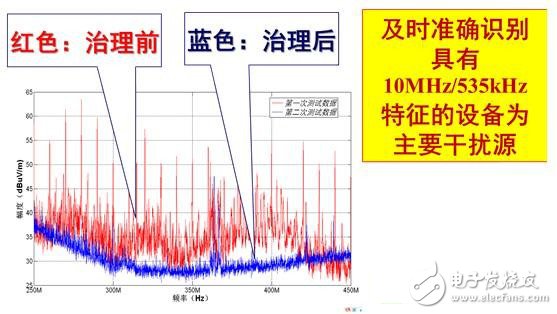
3. For the equipment working condition and functional performance test, the electromagnetic compatibility test needs to clean the electromagnetic environment, so it is usually carried out in the shielding room. However, the system-level dynamic test cannot be implemented in the shielded room, so it needs to be solved: 1) the external field is mixed with the electromagnetic emission of the test object, which affects the objectivity of the test data; 2) the electromagnetic emission of the test system itself and the electromagnetic emission of the test object Mixing into one, affecting the objectivity of test data. At present, China has independently built an open field-system-level electromagnetic compatibility test system, which can complete the system-level dynamic electromagnetic compatibility test of large-scale equipment (including multi-entity equipment). According to the third party test, the open field-system-level electromagnetic compatibility test system has very low electromagnetic noise, which can eliminate the slowly changing electromagnetic interference in the open field, and has the ability to test the external field radiation emission.
4. For the actual use of electromagnetic environment test, the ground air system and the formation battlefield environment need a combination of various technologies, including electromagnetic environment acquisition technology, data processing technology, and simulation construction technology.
V. ConclusionFinally, this report is summarized: Firstly, the system-level electromagnetic environment effect test design is very important. Electromagnetic emission, electromagnetic sensitivity and electromagnetic environment effect are inherent attributes. Electromagnetic compatibility and electromagnetic environment adaptability are designed. System-level electromagnetic environment effect test design It is necessary to fully consider the four relationships: the relationship between electromagnetic compatibility and the electromagnetic environment adaptability of the battlefield, the relationship between the electromagnetic interference characteristics of the equipment subsystem and the electromagnetic compatibility within the system, the relationship between the system-level electromagnetic compatibility and the system-level electromagnetic environment effect, and the system level. The relationship between electromagnetic environmental effects and system-level electromagnetic environment adaptability.
About the author: Su Donglin is a professor and doctoral supervisor at the School of Electronics and Information Engineering, Beijing University of Aeronautics and Astronautics. He is currently the director of Beihang Electromagnetic Compatibility Technology Research Institute.
This article is reproduced in the public number of the Measurement and Control Association, please indicate the author and source.
performance, wide application, wide illumination range, easy to use. LED lamp sealing, dust and insect proof, less cleaning, high light rate, pure light color, no glare, intelligent life, the beauty of details. Selection of good material production, beautiful and practical, heat dissipation without pressure, prevent aging, long bright as new. Good color, easy to clean. We also have Japanese LED bedroom lamp, Japanese LED lamp, Japanese standard LED lighting and so on.
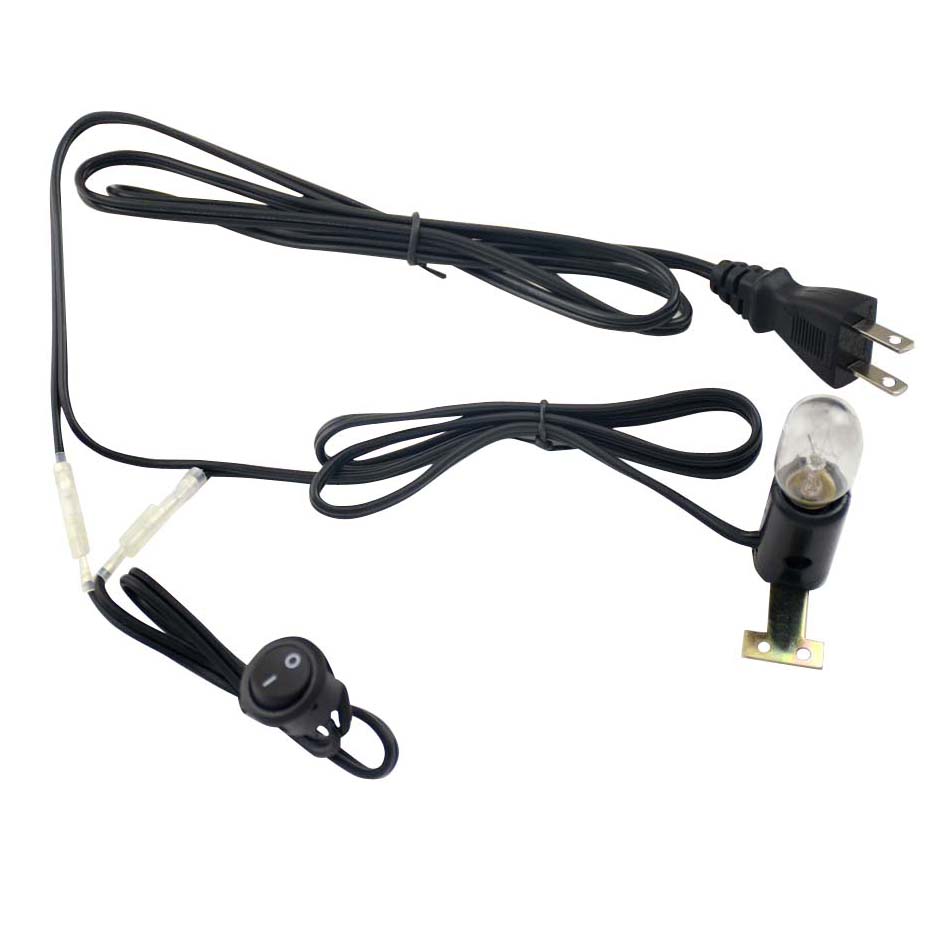
Japanese Lamp,Japanese LED Bedroom Lamp,Japanese LED Light,LED Lighting Japanese Standard
Dongguan baiyou electronic co.,ltd , https://www.dgbaiyou.com